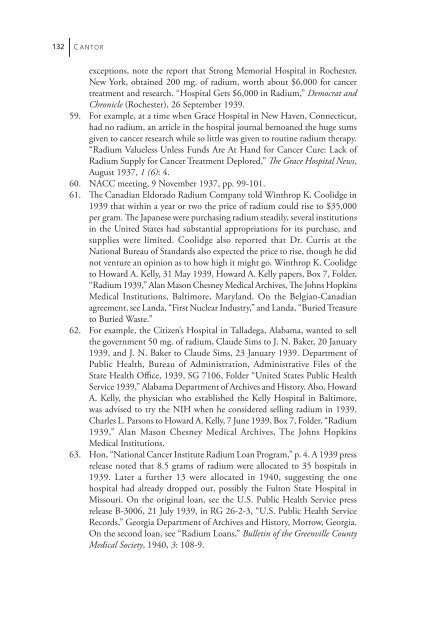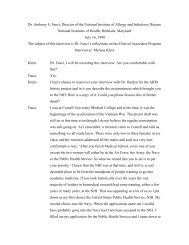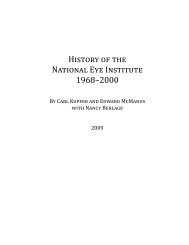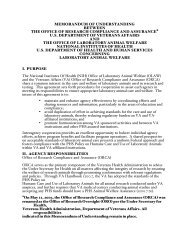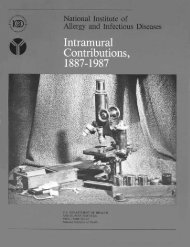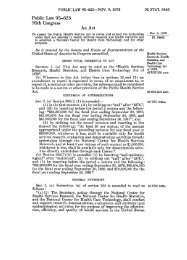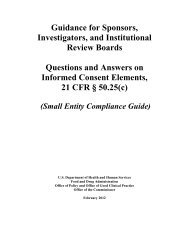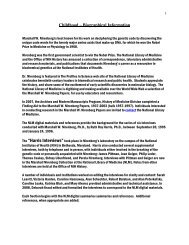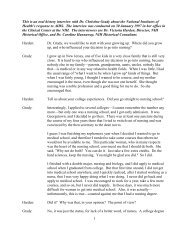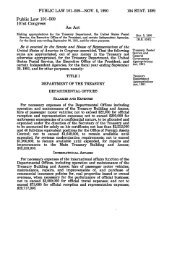Radium and the Origins of the National Cancer Institute
Radium and the Origins of the National Cancer Institute
Radium and the Origins of the National Cancer Institute
You also want an ePaper? Increase the reach of your titles
YUMPU automatically turns print PDFs into web optimized ePapers that Google loves.
132 C a n t o rexceptions, note <strong>the</strong> report that Strong Memorial Hospital in Rochester,New York, obtained 200 mg. <strong>of</strong> radium, worth about $6,000 for cancertreatment <strong>and</strong> research. “Hospital Gets $6,000 in <strong>Radium</strong>,” Democrat <strong>and</strong>Chronicle (Rochester), 26 September 1939.59. For example, at a time when Grace Hospital in New Haven, Connecticut,had no radium, an article in <strong>the</strong> hospital journal bemoaned <strong>the</strong> huge sumsgiven to cancer research while so little was given to routine radium <strong>the</strong>rapy.“<strong>Radium</strong> Valueless Unless Funds Are At H<strong>and</strong> for <strong>Cancer</strong> Cure: Lack <strong>of</strong><strong>Radium</strong> Supply for <strong>Cancer</strong> Treatment Deplored,” The Grace Hospital News,August 1937, 1 (6): 4.60. NACC meeting, 9 November 1937, pp. 99-101.61. The Canadian Eldorado <strong>Radium</strong> Company told Winthrop K. Coolidge in1939 that within a year or two <strong>the</strong> price <strong>of</strong> radium could rise to $35,000per gram. The Japanese were purchasing radium steadily, several institutionsin <strong>the</strong> United States had substantial appropriations for its purchase, <strong>and</strong>supplies were limited. Coolidge also reported that Dr. Curtis at <strong>the</strong><strong>National</strong> Bureau <strong>of</strong> St<strong>and</strong>ards also expected <strong>the</strong> price to rise, though he didnot venture an opinion as to how high it might go. Winthrop K. Coolidgeto Howard A. Kelly, 31 May 1939, Howard A. Kelly papers, Box 7, Folder,“<strong>Radium</strong> 1939,” Alan Mason Chesney Medical Archives, The Johns HopkinsMedical Institutions, Baltimore, Maryl<strong>and</strong>. On <strong>the</strong> Belgian-Canadianagreement, see L<strong>and</strong>a, “First Nuclear Industry,” <strong>and</strong> L<strong>and</strong>a, “Buried Treasureto Buried Waste.”62. For example, <strong>the</strong> Citizen’s Hospital in Talladega, Alabama, wanted to sell<strong>the</strong> government 50 mg. <strong>of</strong> radium, Claude Sims to J. N. Baker, 20 January1939, <strong>and</strong> J. N. Baker to Claude Sims, 23 January 1939. Department <strong>of</strong>Public Health, Bureau <strong>of</strong> Administration, Administrative Files <strong>of</strong> <strong>the</strong>State Health Office, 1939, SG 7106, Folder “United States Public HealthService 1939,” Alabama Department <strong>of</strong> Archives <strong>and</strong> History. Also, HowardA. Kelly, <strong>the</strong> physician who established <strong>the</strong> Kelly Hospital in Baltimore,was advised to try <strong>the</strong> NIH when he considered selling radium in 1939.Charles L. Parsons to Howard A. Kelly, 7 June 1939, Box 7, Folder, “<strong>Radium</strong>1939,” Alan Mason Chesney Medical Archives, The Johns HopkinsMedical Institutions.63. Hon, “<strong>National</strong> <strong>Cancer</strong> <strong>Institute</strong> <strong>Radium</strong> Loan Program,” p. 4. A 1939 pressrelease noted that 8.5 grams <strong>of</strong> radium were allocated to 35 hospitals in1939. Later a fur<strong>the</strong>r 13 were allocated in 1940, suggesting <strong>the</strong> onehospital had already dropped out, possibly <strong>the</strong> Fulton State Hospital inMissouri. On <strong>the</strong> original loan, see <strong>the</strong> U.S. Public Health Service pressrelease B-3006, 21 July 1939, in RG 26-2-3, “U.S. Public Health ServiceRecords,” Georgia Department <strong>of</strong> Archives <strong>and</strong> History, Morrow, Georgia.On <strong>the</strong> second loan, see “<strong>Radium</strong> Loans,” Bulletin <strong>of</strong> <strong>the</strong> Greenville CountyMedical Society, 1940, 3: 108-9.


